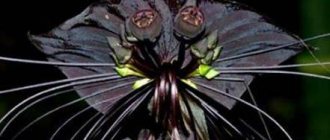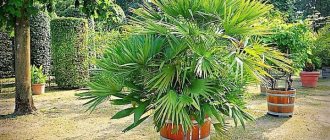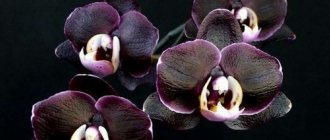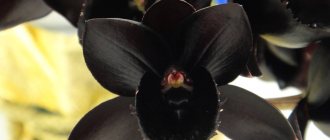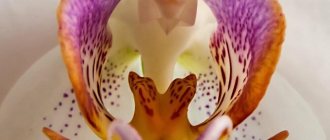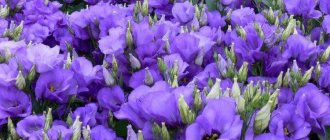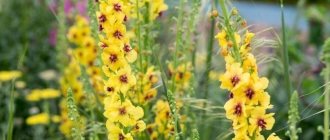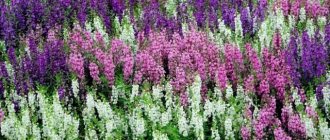Description
In the natural environment it is impossible to find black, blue and purple orchids in their pure form. These are always some shades, combinations with other colors, for example, with yellow or white strokes or spots.
Burgundy orchids can be found more often; by the way, specimens with a thick burgundy color of flowers are classified as black orchids.
How to avoid getting caught by artificially colored plants?
There are several ways to artificially give orchid flowers the desired color, one of which is to introduce dye through the root system during watering. In this case, not only flowers are painted over, but also roots and even leaves.
Such plants do not live long, often lose the green mass of their leaves and eventually die.
Another way to color flowers in the desired color is by injecting dyes into the peduncle. In this case, less damage is done to the health of the flower, but the next time it blooms you will get a natural color.
It must be remembered that the color of a dark orchid also greatly depends on the lighting.
Advice! To distinguish a colored flower from a natural one, you need to understand that orchids do not have blue, blue, coral, acidic shades of green and yellow pigment in nature.
Dark orchids: varieties and photos
Dracula roezlii
This species is classified as a black orchid due to the blue-black veins located on the strap-shaped flowers. The plant is not large, but very exotic and unusual.
Also known as Monkey Face.
Dracula roezlii.
Black Butterfly
The color of the flower on the peduncle of this phalaenopsis depends on where it is located: the lower flowers are almost black, with white spots.
The higher the flower is located on the peduncle, the less dark pymentum it contains ; the uppermost ones can generally be light with dark speckles.
Black Butterfly.
Maxillaria schunkeana
This variety of orchids is not only graceful, beautiful and elegant, but also has fragrant, small dark flowers , rapidly unfolding on the peduncle, resembling a triangle in shape.
Maxillaria schunkeana.
Fredclarkeara After Dark SVO Black Pearl
This variety is a complex hybrid of catasetum , one of the most unusual and striking orchids. It has small deep black flowers with a honey aroma.
In winter, it sheds its leaves , and the supply of nutrients is located in the green pseudobulb. It blooms once a year at the end of summer, when the complete formation of green mass ends.
Fredclarkeara After Dark SVO Black Pearl.
Paphiopedium de Nachtwacht
A bright and unusual representative of paphiopedilums pleases the eye with burgundy-brown shoe-shaped flowers, small, delicate and very graceful.
No more than two flowers appear on the peduncle at the same time.
Paphiopedium de Nachtwacht.
Paphiopedium Pisgah Midnight
The darkest of the paphiopedilums is a flower with black-purple petals and a crimson throat and a yellow center.
The plant prefers a woody substrate, the roots are photosynthetic, so it is grown in transparent pots.
Paphiopedium Pisgah Midnight.
Natural views
To this day, this is a complex question with no clear answer. In nature you can find dark orchids, almost black, but they are always deep shades of burgundy, purple or blue.
Dracula roezlii - grows naturally in tropical forests; there is no black pigment in its flowers, but there is a deep burgundy pigment.
Several varieties of Papheupedilum also have dark pigments and can be called black orchids.
Myths about black varieties of orchids
The most common myth about the appearance of the black orchid is associated with the name of a botanist who is believed to have stolen this flower from a South American aboriginal tribe , where it was considered a totem plant.
For this act, the scientist was subjected to severe torture, however, thanks to his suffering, the world became aware of the existence of this wonderful flower.
A more romantic story of the appearance of the black orchid is associated with the story of unhappy love. However, skeptics have a different opinion: they confidently claim that the black orchid was bred artificially by Californian scientists.
Historical background on selection
It is known that there is no natural black pigment in nature; therefore, all varieties of flowering plants with black flowers are the result of the complex work of skilled breeders.
Now, in addition to the unusual colors, scientists endow the unusual tones of orchids with the aroma of vanilla or honey, which undoubtedly adds value to the bred specimens. It is worth noting that this work is very expensive, but the amazing flowers that gardeners can enjoy are in great demand among collectors.
Morphological features
Dark orchids are found among many varieties of these plants:
- Cattleya;
- Phalaenopsis;
- Dendrobiums;
- Papheopedilum;
- Oncidiums;
- Cymbidiums.
Cattleyas are orchids whose rosette of leaves can consist of one, two or three leaves, the flowers are large and fragrant.
Cattleya aclandiae is dark in color.
Phalaenopsis is the largest group of orchids, beloved by gardeners, both professionals and amateurs:
- distinctive feature - photosynthetic roots;
- The rosette of leaves is on average composed of 7 - 8 leaf blades;
- the peduncle can reach 50 cm in large-sized ones and 10 cm in dwarf subspecies;
- The diameter of the flower is from 6 to 12 cm, the number of them on the peduncle varies.
Above we have already given a photo of the dark phalaenopsis Black Butterfly. But here's one more thing

